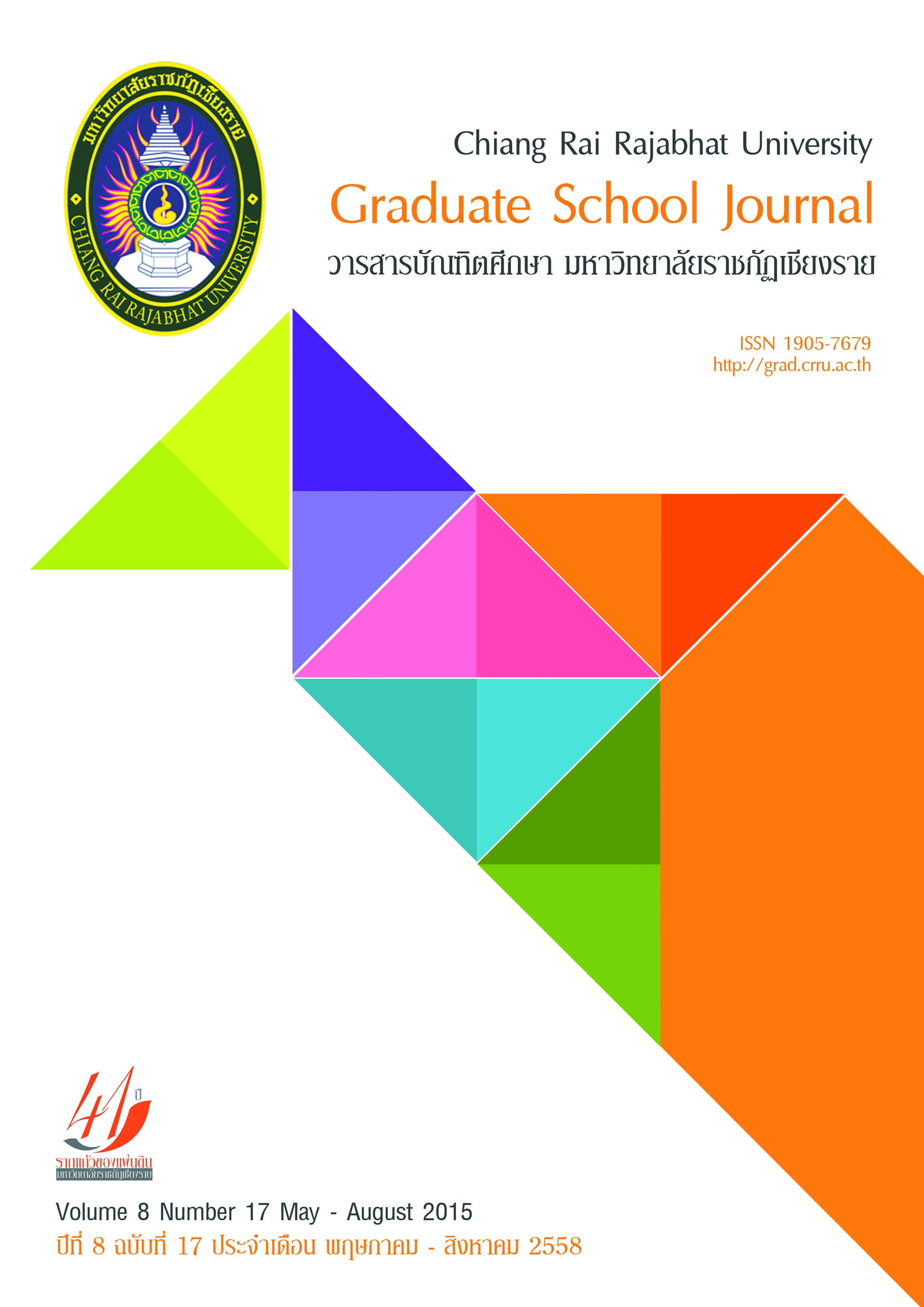การเปรียบเทียบผลสัมฤทธิ์ทางการเรียนเรื่องการแต่งฉันท์ ของนักเรียนชั้นมัธยมศึกษาปีที่ 5 ด้วยวิธีการจัดการเรียนแบบร่วมมือ (STAD) กับแบบนิรนัย
Main Article Content
Abstract
1. ประสิทธิภาพของแผนการจัดการเรียนรู้ที่ใช้วิธีการสอนแบบร่วมมือ (STAD) มีค่าประสิทธิภาพ (E1/E2) เท่ากับ 80.38/83.08 และแผนการจัดการเรียนรู้ที่ใช้วิธีการสอนแบบนิรนัยมีค่าประสิทธิภาพ (E1/E2) เท่ากับ 80.35/84.16 ซึ่งสูงกว่า เกณฑ์ที่กำหนดไว้ 80/80 ทั้ง 2 รูปแบบ
2. ผลสัมฤทธิ์ทางการเรียนจากการจัดการเรียนรู้ ด้วยวิธีการสอนแบบร่วมมือ (STAD) คะแนนหลังเรียนสูงกว่า ก่อน เรียนอย่างมีนัยสำคัญที่ระดับ 0.1 และวิธีการสอนแบบนิรนัยคะแนนผลสัมฤทธิ์ทางการเรียนหลังเรียนสูงกว่าก่อนเรียนอย่างมีนัย สำคัญที่ระดับ 0.1
3. ผลสัมฤทธิ์ทางการเรียนหลังเรียนของนักเรียนที่เรียนด้วยวิธีการสอนแบบร่วมมือ (STAD) กับแบบนิรนัยมีความแตก ต่างกัน โดยผลสัมฤทธิ์ทางการเรียนหลังเรียนของนักเรียนที่เรียนด้วยวิธีการสอนแบบร่วมมือ (STAD) สูงกว่าแบบนิรนัยอย่างมีนัย สำคัญที่ระดับ 0.1
4. ความพึงพอใจของนักเรียนที่มีต่อการจัดการเรียนรู้ด้วยวิธีการสอนแบบร่วมมือ (STAD) โดยภาพรวมอยู่ในระดับมาก ที่สุด ( = 4.81, S.D. = 0.40) และแบบนิรนัยอยู่ในระดับมากที่สุด (
= 4.78, S.D. = 0.37) เช่นกัน
Comparison of Learning Achievement on Composing Poem of Matthayomsuksa 5 Students using Student Team Achievement Division (STAD) and Deductive Method
The purposes of this study were: 1) to investigate the efficiency of teaching peom composition using Student Team Achievement Division (STAD) versus Deductive Method; 2) to compare students’ learning acheivement on poem composition between pre and post implementation of the instruction based on Student Team Achievement Division (STAD) versus Deductive Method; 3) to compare students’ learning achievement on poem composition after implementing Student Team Achievement Division (STAD) versus Deductive Method; and 4) to examine the students’ satisfaction towards the instruction based on Student Team Achievement Division (STAD) versus Deductive Method. The findings showed that:
1. Efficiency results (E1/E2) of the instruction based on Student Team Achievement Division (STAD) were 80.38/83.08, and that of the Deductive Method were 80.35/84.16. The E1/E2 scores of the two types of instruction were higher than the standard 80/80 criteria.
2. Posttest scores of the learning achievement based on Student Team Achievement Division (STAD) and Deductive Method were significantly higher than that of the pretest scores at the confidence level of .01.
3. Posttest scores of the learning achievements based on Student Team Achievement Division (STAD) and Deductive Methods were different in that the learning achievement based on Student Team Achievement Division (STAD) was significantly higher than that of the Deductive Method at the confidence level of .01.
4. Students’ satisfaction towards the instruction based on Student Team Achievement Division (STAD) and Deductive Method were, in overall, at the highest levels, that is, ( = 4.81, SD = 0.40) and (
= 4.78, SD = 0.37).
Article Details
บทความที่ได้รับการตีพิมพ์เป็นลิขสิทธิ์ของวารสารมหาวิทยาลัยราชภัฎเชียงราย
ข้อความที่ปรากฏในบทความแต่ละเรื่องในวารสารวิชาการเล่มนี้เป็นความคิดเห็นส่วนตัวของผู้เขียนแต่ละท่านไม่เกี่ยวข้องกับมหาวิทยาลัยราชภัฎเชียงราย และคณาจารย์ท่านอื่นๆในมหาวิทยาลัยฯ แต่อย่างใด ความรับผิดชอบองค์ประกอบทั้งหมดของบทความแต่ละเรื่องเป็นของผู้เขียนแต่ละท่าน หากมีความผิดพลาดใดๆ ผู้เขียนแต่ละท่านจะรับผิดชอบบทความของตนเองแต่ผู้เดียว

